The Technical Forum was held on the 5th of April, on the first day of the Miami Members' Meeting.
Regulatory update: “Presently ethoxyquin remains not permitted in either fishmeal or feed in the EU”
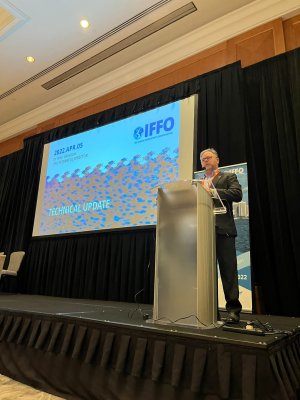 “EFSA’s recent scientific opinion on ethoxyquin, acknowledged many of the concerns and data gaps identified in the first opinion, which have been clarified subsequently” Dr Brett Glencross, IFFO’s Technical Director explained. Presently ethoxyquin remains not permitted in either fishmeal or feed in the EU. The European Commission has amended the “Suspension Regulation” (to be reviewed by 31st December 2022). Other countries’ regulatory agencies however, (e.g. US-FDA and MOA-China) have examined the safety of ethoxyquin and maintained its use as an antioxidant.
“EFSA’s recent scientific opinion on ethoxyquin, acknowledged many of the concerns and data gaps identified in the first opinion, which have been clarified subsequently” Dr Brett Glencross, IFFO’s Technical Director explained. Presently ethoxyquin remains not permitted in either fishmeal or feed in the EU. The European Commission has amended the “Suspension Regulation” (to be reviewed by 31st December 2022). Other countries’ regulatory agencies however, (e.g. US-FDA and MOA-China) have examined the safety of ethoxyquin and maintained its use as an antioxidant.
In response to these changes, IFFO is running a project examining the potential of a range of different and novel antioxidants, compared against ethoxyquin, using two different oxygen bomb meters.
Another antioxidant BHT still remains within a reauthorisation process as a feed additive in the EU, EFSA’s Scientific Opinion is still to be published (due 2022).
Regarding the current European Commission rules on banning the dual use of an establishment for production of both direct human consumption and Feed Grade fish oils, the European Commission ‘s Directorate General of Health (DG SANTE) has maintained their position. Both EFFOP and IFFO are taking a coordinated approach. Concurrently, SANIPES (National Fisheries Health Organization of Peru) has raised issues linked to these same European Hygiene Regulations and has mandated all production lines in Peru to be compliant with human consumption grade oil destined for the EU.
The US’ Marine Mammal Protection Act (MMPA): what is at stake
In the US, the Marine Mammal Protection Act (MMPA) aims to reduce marine mammal bycatch associated from international commercial fishing operations, explained Dr Brett Glencross. It requires foreign fisheries exporting fish and fish products to the US to have standards comparable (and a comparability finding) in effectiveness to those used in the US. The five-year exemption period ended in 2021 and a comparability finding from the US for international commercial fishing operations will be handed down before December 31, 2022. NOAA has commented that there is no desire to disrupt legitimate trade with import prohibitions on highly processed products unlikely to be imposed without due consideration of the risks of unintended trade disruption and a recognition of goods in storage/transit.
Life Cycle Assessment (LCA): comparing the full range of environmental effects assignable to products and services
A key area of focus is on Life Cycle Assessment (LCA). “It aims to compare the full range of environmental effects assignable to products and services by quantifying all inputs and outputs of material flows and assessing how these material flows affect the environment”, Brett Glencross explained. There have been various attempts to set some standards on this (ISO and EU Product Environmental Footprint (PEF) Categorisation Rules). With the aim of sharing data and progressing understanding, IFFO joined The Global Feed LCA Institute (GFLI), an independent animal nutrition and food industry institute with the purpose of developing a publicly available Animal Nutrition Life Cycle Analysis (LCA) database. The potential benefits of this work include supporting producers in establishing the right processes and understanding benefits and claims. It will also give users a clearer understanding of the claims, with fairer competition among suppliers.
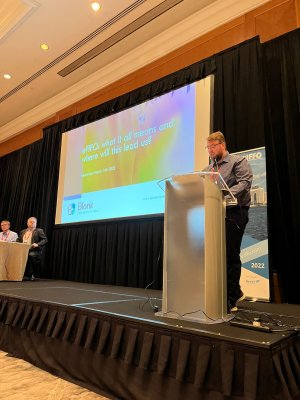 eFIFO: what it all means and where will this lead us?
eFIFO: what it all means and where will this lead us?
The Fish in: Fish out ratio is the ratio between fish caught to produce marine ingredients in the feed to the fish produced in aquaculture. “However, this ratio overestimates the impact of marine ingredients in aquaculture and is often used incorrectly or with double counting”, said Björn Kok, Data and Methodology Specialist, Blonk Sustainability, The Netherlands and PhD student at the Institute of Aquaculture, University of Stirling, U.K.
This happens because often the methods do not account for the multiple users for marine ingredients, for example salmon require more fish oil then fishmeal, but the surplus fishmeal is then consumed elsewhere. These methods are therefore incompatible with the calculation of other environmental footprints such as Climate change or carbon footprint, Water and Land use.
eFIFO helps solve the double counting issue by using an approach commonly used in life cycle assessment. The results of the eFIFO against the old 5:1 FIFO claim show that the eFIFO ratio is much lower, around 2.5; and in 2020 it was less than 1. This difference is because the earlier methods calculate both the fish used for the fishmeal and the fish needed for the additional fish oil. But neglect the fishmeal that is produced simultaneously and is used in other aquaculture species such as catfish or in other industries. Whereas the eFIFO method avoids this by using economic allocation.
eFIFO shows that aquaculture produces three to four times more fish than is used in the feed.
Watch the eFIFO video from Bjorn Kok here
Benefits of the Global Feed Lifecycle Assessment Institute (GFLI) database
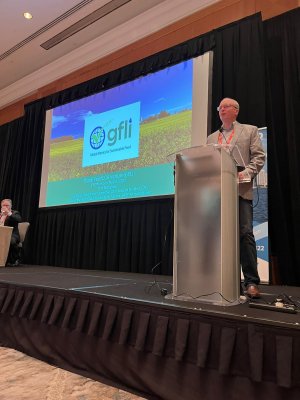 “GFLI’s database allows feed, livestock and aquaculture sectors to use data based on a harmonized methodology and calculate the environmental footprint of products in a transparent and trustworthy manner. It also allows to benchmark and make meaningful comparisons” explains Tom Battagliese, Chair of the Technical Management Committee, GFLI.
“GFLI’s database allows feed, livestock and aquaculture sectors to use data based on a harmonized methodology and calculate the environmental footprint of products in a transparent and trustworthy manner. It also allows to benchmark and make meaningful comparisons” explains Tom Battagliese, Chair of the Technical Management Committee, GFLI.
This makes it possible to produce feed with a lower footprint/tonne to food products with a lower footprint/kg (farmed fish/pig/poultry). The database does not just cover the production units, but cover the feed ingredients and their processing, through to the on-farm production, to processing, distribution, consumption and waste disposal. It is aligned with the FAO-LEAP guidelines for feed ensures to the integrity & quality of LCA feed datasets, covering impacts such as on climate change, ozone depletion, human toxicity, acidification etc.
Currently there are approximately 1,000 datasets available from Canadian and US crops, and main feed ingredients in Europe. Further data is underway on Brazilian crops, US processed ingredients, fish feed and feed additives. Each dataset covers 19 impact categories and includes DQR scores (PEF Method).
Reduction fisheries sustainability: an industry wide approach is recommended
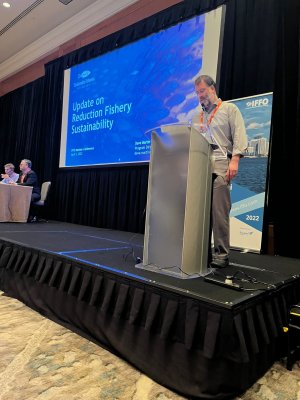 Sustainable Fisheries Partnership’s Dave Martin presented the latest from their Reduction Fisheries report (December 2021), which evaluated 25 key fish stocks used for reduction and rated the majority as ‘reasonably well managed’ or better. There has been a steady improvement in the number of certified fisheries, with a slight reduction in 2021 due to blue whiting and Norway herring. The majority of fisheries remain at the reasonably managed level and these are the key fisheries for salmon feed, but more is needed for them to improve further.
Sustainable Fisheries Partnership’s Dave Martin presented the latest from their Reduction Fisheries report (December 2021), which evaluated 25 key fish stocks used for reduction and rated the majority as ‘reasonably well managed’ or better. There has been a steady improvement in the number of certified fisheries, with a slight reduction in 2021 due to blue whiting and Norway herring. The majority of fisheries remain at the reasonably managed level and these are the key fisheries for salmon feed, but more is needed for them to improve further.
Target 75 is an initiative to ensure that 75% of seafood in 13 key sectors is either sustainable or making regular, verifiable improvements. An expanded definition was adopted in 2021 using standard FAO species groups and data to improve tracking. It again shows that improvements have become stalled with lots of work still to do.
There is range of ways to assess marine ingredients, from FIPs and certification standards. For seafood buyers, SFP recommends an industry wide approach as the challenges are too big to go to one company or one supply chain at a time. Transparency should be demanded not only for salmon feed, already under heavy scrutiny, but also for shrimp, pangasius or even chicken and pork. Buyers should stay engaged and not abandon hot spots like West Africa or SE Asia. SFP has taken further action by launching the Global Roundtable on Marine Ingredients to drive dialogue and action together with IFFO and value chain representatives.
Standard development essentials
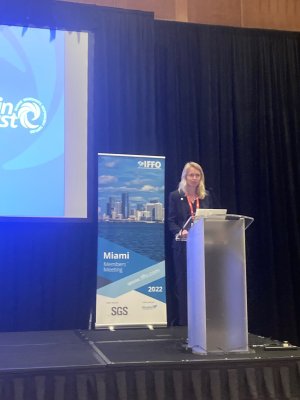 Listening to certificate holders & stakeholders globally, looking at recognition and synergies with other standards, and trialling all criteria are instrumental to MarinTrust explained Libby Woodhatch, its Executive Chair. Further review of MarinTrust Factory Standard V2 is underway and subject to several regional workshops, aimed at considering the effects of any proposed changes to the current Standard.
Listening to certificate holders & stakeholders globally, looking at recognition and synergies with other standards, and trialling all criteria are instrumental to MarinTrust explained Libby Woodhatch, its Executive Chair. Further review of MarinTrust Factory Standard V2 is underway and subject to several regional workshops, aimed at considering the effects of any proposed changes to the current Standard.
Additional key performance metrics on social criteria will be included as well as updated clauses on by-products and their traceability.
Formal pilots will be undertaken by Certification Bodies - late April-June 2022. “Pilots will be in different formats, including remote and enhanced remote auditing. We're looking for sites across the world, ideally in each major region/continent” adds Woodhatch.
There will be a 60-day public consultation prior to final sign-off by the multistakeholder MarinTrust Governing Body Committee in Q3 2022.
“Nothing is set in stone yet” she concluded.
5th April 2022








